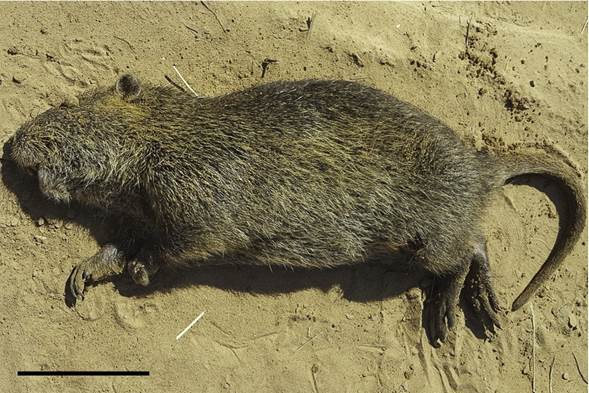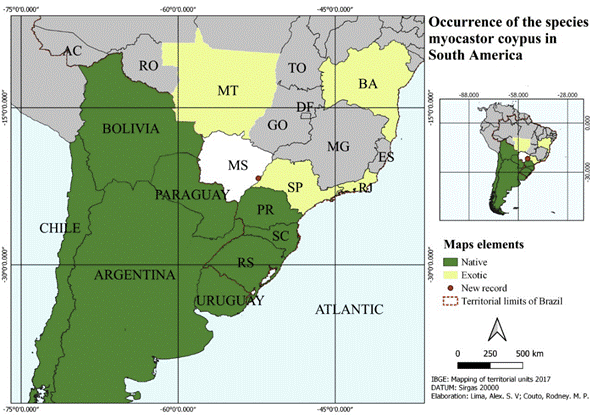Myocastor coypus (coypu / nutria) is a rodent (Lacher et al., 2020; Patton et al., 2015) of the Myocastoridae family (Wilson and Reeder, 2005), an excellent swimmer which easily colonizes available habitats (Bueno, 2013). It is a large rodent 1-10 kg (Bonvicino et al., 2008; Paglia et al., 2012), body 40-60 cm; tail 30-45cm (Oliveira and Bonvicino, 2006), with dorsal yellowish-grey fur, streaked with black hair, the sides are lighter, the ventral region is whitish with a cylindrical tail (Oliveira and Bonvicino, 2006; Woods et al., 1992). Feet are much longer than hands, and contain five digits, four of which are connected by a membrane and the fifth is free. Hands have four digits, long, flexible and free; the incisors are highlighted and bright orange yellow (unlike those in rats which are brown-yellow), with white marks on the muzzle (Bueno, 2013; Oliveira y Bonvicino, 2006; Woods et al., 1992). They are abundant in freshwater, brackish and saltwater marshes, but they may also live along lentic lakes and streams (Nowak, 1999), with a preference for humid areas with emerging vegetation and areas with succulent vegetation along the banks (Greer, 1966). Although they feed mainly on vegetable matter, they can occasionally prey on molluscs and the eggs of waterfowl (Angelici et al., 2012; Scaravelli, 2002).
The species is native from southern South America, occurring in Argentina, Bolivia, Chile, Paraguay, Uruguay, and southern Brazil (Guichón et al., 2003; Oliveira and Bonvicino, 2006; Woods et al., 1992). In Brazil, its original distribution includes the states of Rio Grande do Sul, Santa Catarina, and Paraná (Bavaresco et al., 2017; Bonvicino et al., 2007; Cherem et al., 2004; Moojen, 1952), but it has been introduced in other states, such as São Paulo (De Vivo et al., 2011), or dispersed to Rio de Janeiro (Bueno, 2013). The bathing rat was introduced in several countries around the world for the value of its skin and its meat, including Italy (Bertolino and Ingegno, 2009; Prigioni et al., 2005) and Great Britain (Harris, 1995), Finland and North America (Guichón et al., 2003), causing damage to the natural environment of the invaded areas (Genovesi et al., 2009). There are reports of the presence of this species also across Asia, including Japan, China, South Korea, and Thailand and in Africa (Kenya, Zimbabwe, Zambia, and Botswana) (Carter and Leonard, 2002). Thus, M. coypus has been introduced on all continents, except Australia and Antarctica (Bueno, 2013) and on the Caribbean islands (Borroto-Páez and Woods, 2012). According to Woods et al. (1992), the species may have been introduced in certain regions of the world in the hope of reducing populations of undesirable aquatic plants.
The species is classified by the International Union for the Conservation of Nature (IUCN) as one of the 100 worst invasive alien species in the world, considered exotic in 44 countries (Global Invasive Species Database [GISD], 2020; Lowe et al., 2000). Among other impacts are its ability to compete for niches with native species, to destroy waterfowl nests in search of eggs (Angelici et al., 2012; Scaravelli, 2002), and due to their digging habits, to weaken and damage riverbanks (GISD, 2020; Guichón and Cassini, 2005). Also, according to Carter and Leonard (2002), they can feed on agricultural crops, including sugar cane, alfalfa, and other roots (Woods et al., 1992); in studies carried out in France and Brazil by Ménard et al. (2001) and El-Kouba et al. (2009), M. coypus is reported as a host of Fasciola hepatica. Howerth et al. (1994), studying a population of M. coypus in Louisiana (USA) registered Toxoplasma gondii, Chlamydua psittaci and Leptospira sp. serogroups.

Figure 1 Myocastor coypus record being run-over and dead on a side road near wetlands and a dam, in a rural area in the municipality of Bataguassu (21°44’28.46” S; 52°20’8” W), east of the State of Mato Grosso do Sul, Brazil (10 cm bar).
On April 23, 2018, at approximately 18:00, an adult specimen with a 40 cm (Figure 1) was recorded as being run over on a side road near wetlands and a dam in a rural area in the municipality of Bataguassu, east of the State of Mato Grosso do Sul (21°44’28.46” S; 52°20’8” W) (Figure 2). The region was originally composed of savannah vegetation (Cerrado sensu strictu and Cerradão) (Pott et al., 2014). The climate according to the Köppen classification is the humid tropical (Aw), characterized by two well-defined seasons of dry winters (April - September) and rainy summers (October - March), with annual precipitation ranging between 1400 and 1700 mm, in which November, December and January are the rainiest months (Zavattini, 2009). The average temperature in the coldest month is over 18 ºC while the average annual maximum is between 27 °C and 32 °C, with absolute maximum between 35 °C and 40 °C while the absolute minimum can reach 0 °C (Oliveira et al., 2000; Walter, 2006). According to the Specialist Group on Invasive Species (ISSG), M. coypus, is one of the few mammal species that can be successfully considered invasive, present in forty-four countries (GISD, 2020). Considering the great capacity of dispersion and colonization of new habitats of M. coypus and in view of all the problems already presented, it is necessary to monitor this species in any new environments populated by it.

Figure 2 Distribution of Myocastor coypus in South America. Countries in Latin America and Brazilian states where the species is considered native in green. Brazilian states where the species is considered exotic in yellow. Red dot indicates place of registration of the present study (Mato Grosso do Sul state).
This study presents the first record of Myocastor coypus in the state of Mato Grosso do Sul and defined its distribution in the south of South America, highlighting where it is considered native or exotic within Brazil (Table 1 and Figure 2). This finding widens the distribution of Myocastor coypus in Brazil (Figure 2). It is not known for certain which states (where it is non-native) the species arrived first. M. coypus is believed to have been introduced in the state of São Paulo due to the economic values related to its meat and skin. For the other states, it is not known whether it was introduced, or the occupation occurred naturally.
Table 1 Reports of Myocastor coypus within Brasil
| State | City | Reference | State | City | Reference |
|---|---|---|---|---|---|
| BA | Ourolândia* | GBIF, 2020 | MT | - | GBIF, 2020 |
| MT | - | GBIF, 2020 | PR | Curitiba | GBIF, 2020 |
| PR | Bom Jesus do Sul | Wolfart et al. 2013 | PR | Curitiba | El-Kouba et al. 2009 |
| PR | Curitiba | GBIF, 2020 | PR | Palotina | Bavaresco et al. 2017 |
| PR | Ouro Verde | Aguiar et al. 2007 | RJ | Três Rios | Bueno, 2013 |
| PR | Quedas do Iguaçu | Juraszek et al. 2014 | RS | Cruz Alta | GBIF, 2020 |
| RS | Cachoeira do Sul | GBIF, 2020 | RS | Mostardas | GBIF, 2020 |
| RS | Cruzeiro do Sul | GBIF, 2020 | RS | Quinta | GBIF, 2020 |
| RS | Pareci Novo | Kasper et al. 2007 | RS | Rio Grande | Espinelli et al. 2014 |
| RS | Rincão Del Rei | GBIF, 2020 | RS | Santa Vitória do Palmar* | GBIF, 2020 |
| RS | Santa Izabel do Sul | Colares et al. 2010 | RS | Tramandaí | GBIF, 2020 |
| RS | Santa Vitória do Palmar | Colares et al. 2010 | SC | Campo Belo do Sul | Kasper et al. 2012 |
| SC | Campeche | GBIF, 2020 | SC | Jaguarura | Cherem et al. 2004 |
| SC | Florianópolis | Cherem et al. 2004 | SC | Rio do Sul | GBIF, 2020 |
| SC | Paulo Lopes | Cherem et al. 2004 | SP | Cubatão | GBIF, 2020 |
| SP | Araraquara | GBIF, 2020 | SP | Guarulhos | GBIF, 2020 |
| SP | Campinas | GBIF, 2020 | SP | Jundiaí | GBIF, 2020 |
| SP | Itatiba | GBIF, 2020 | SP | Limeira | GBIF, 2020 |
| SP | Jaguariúna | GBIF, 2020 | SP | Piracicaba | GBIF, 2020 |
| SP | Pedreira | Bonvicino et al. 2007 | SP | Porto Ferreira | GBIF, 2020 |
*Fossil records
BA = Bahia; MT = Mato Grosso; PR = Paraná; RJ = Rio de Janeiro; RS = Espírito Santo; SC = Santa Cataria and SP = São
It is not possible to state the origin of M. coypus reported in the present study, whether it was introduced or dispersed naturally in the swampy areas of the Paraná River, since the species has records on the border with the states of Mato Grosso do Sul and Paraná, where it is considered native, about 150 km from the record site (Aguiar et al., 2007). However, the record of an adult specimen may indicate the presence of other individual in the area and, considering the life cycle where sexual maturity varies between 3-10 months with a gestation of 127-138 days and with litters that vary of 5-13 pups (Oliveira and Bonvicino, 2006; Woods et al., 1992), has a great potential of becoming an invasive species in the state. It is necessary to implement monitoring programs to determine whether the species is present in the area, whether the presence is a result of natural expansion of nearby populations due to changes in the habitats or whether the animals have been introduced and can cause severe impacts on local ecosystems. Given that the record was obtained through an opportunistic way and since in this case we had no license to collect or transport wild animals, we performed a photographic record, and the image is deposited in the UFMS Reference Zoological Collection (ZUFMS-MNV00149).














